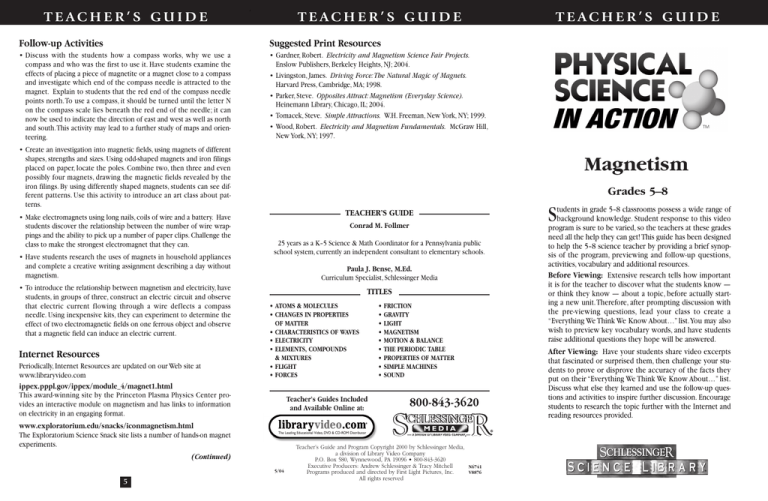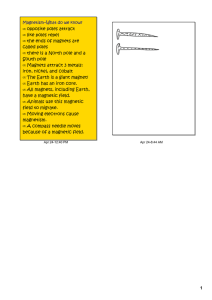
TEACHER’S GUIDE
TEACHER’S GUIDE
TEACHER’S GUIDE
Follow-up Activities
Suggested Print Resources
• Discuss with the students how a compass works, why we use a
compass and who was the first to use it. Have students examine the
effects of placing a piece of magnetite or a magnet close to a compass
and investigate which end of the compass needle is attracted to the
magnet. Explain to students that the red end of the compass needle
points north.To use a compass, it should be turned until the letter N
on the compass scale lies beneath the red end of the needle; it can
now be used to indicate the direction of east and west as well as north
and south.This activity may lead to a further study of maps and orienteering.
• Gardner, Robert. Electricity and Magnetism Science Fair Projects.
Enslow Publishers, Berkeley Heights, NJ; 2004.
• Livingston, James. Driving Force: The Natural Magic of Magnets.
Harvard Press, Cambridge, MA; 1998.
• Parker, Steve. Opposites Attract: Magnetism (Everyday Science).
Heinemann Library, Chicago, IL; 2004.
• Tomacek, Steve. Simple Attractions. W.H. Freeman, New York, NY; 1999.
• Wood, Robert. Electricity and Magnetism Fundamentals. McGraw Hill,
New York, NY; 1997.
• Create an investigation into magnetic fields, using magnets of different
shapes, strengths and sizes. Using odd-shaped magnets and iron filings
placed on paper, locate the poles. Combine two, then three and even
possibly four magnets, drawing the magnetic fields revealed by the
iron filings. By using differently shaped magnets, students can see different patterns. Use this activity to introduce an art class about patterns.
• Make electromagnets using long nails, coils of wire and a battery. Have
students discover the relationship between the number of wire wrappings and the ability to pick up a number of paper clips. Challenge the
class to make the strongest electromagnet that they can.
• Have students research the uses of magnets in household appliances
and complete a creative writing assignment describing a day without
magnetism.
• To introduce the relationship between magnetism and electricity, have
students, in groups of three, construct an electric circuit and observe
that electric current flowing through a wire deflects a compass
needle. Using inexpensive kits, they can experiment to determine the
effect of two electromagnetic fields on one ferrous object and observe
that a magnetic field can induce an electric current.
Internet Resources
Periodically, Internet Resources are updated on our Web site at
www.libraryvideo.com
ippex.pppl.gov/ippex/module_4/magnet1.html
This award-winning site by the Princeton Plasma Physics Center provides an interactive module on magnetism and has links to information
on electricity in an engaging format.
Magnetism
Grades 5–8
Conrad M. Follmer
25 years as a K–5 Science & Math Coordinator for a Pennsylvania public
school system, currently an independent consultant to elementary schools.
Paula J. Bense, M.Ed.
Curriculum Specialist, Schlessinger Media
TITLES
• ATOMS & MOLECULES
• CHANGES IN PROPERTIES
OF MATTER
• CHARACTERISTICS OF WAVES
• ELECTRICITY
• ELEMENTS, COMPOUNDS
& MIXTURES
• FLIGHT
• FORCES
Teacher’s Guides Included
and Available Online at:
www.exploratorium.edu/snacks/iconmagnetism.html
The Exploratorium Science Snack site lists a number of hands-on magnet
experiments.
(Continued)
5/04
5
• FRICTION
• GRAVITY
• LIGHT
• MAGNETISM
• MOTION & BALANCE
• THE PERIODIC TABLE
• PROPERTIES OF MATTER
• SIMPLE MACHINES
• SOUND
800-843-3620
Teacher’s Guide and Program Copyright 2000 by Schlessinger Media,
a division of Library Video Company
P.O. Box 580, Wynnewood, PA 19096 • 800-843-3620
Executive Producers: Andrew Schlessinger & Tracy Mitchell
Programs produced and directed by First Light Pictures, Inc.
All rights reserved
tudents in grade 5–8 classrooms possess a wide range of
background knowledge. Student response to this video
program is sure to be varied, so the teachers at these grades
need all the help they can get! This guide has been designed
to help the 5–8 science teacher by providing a brief synopsis of the program, previewing and follow-up questions,
activities, vocabulary and additional resources.
Before Viewing: Extensive research tells how important
it is for the teacher to discover what the students know —
or think they know — about a topic, before actually starting a new unit.Therefore, after prompting discussion with
the pre-viewing questions, lead your class to create a
“Everything We Think We Know About…” list.You may also
wish to preview key vocabulary words, and have students
raise additional questions they hope will be answered.
After Viewing: Have your students share video excerpts
that fascinated or surprised them, then challenge your students to prove or disprove the accuracy of the facts they
put on their “Everything We Think We Know About…” list.
Discuss what else they learned and use the follow-up questions and activities to inspire further discussion. Encourage
students to research the topic further with the Internet and
reading resources provided.
S
TEACHER’S GUIDE
N6741
V8876
Program Summary
A basic principle of magnetism is that opposites attract and likes repel.
Magnets are materials with two poles that can attract some objects, repel
others and are surrounded by an invisible field of force. Objects made of
some metals are attracted to magnets; this attraction pulls the substance and
the magnet together. All objects containing iron are called ferromagnetic
due to the magnetic qualities of iron. In an investigation using iron filings
and magnets, magnetic fields are observed as the poles of two different
magnets are placed near each other. For hundreds of years, people have
used compasses for navigation without fully understanding how the
science of magnetism makes them useful tools.
To explain the force of magnetism, we explore magnetic domains at the
atomic level. Atoms of magnetic materials are arranged in small groups
called domains. Each domain consists of billions of atoms and acts like a
small magnet. In a substance that is not magnetized, domains are pointed in
random ways. In magnets, all domains are lined up in the same direction.
Temporary magnets can be made by placing certain materials, like steel
paperclips, within a magnetic field.
Electromagnetism is the close relationship between magnetism and electricity — an electric current can induce a magnetic field, and moving magnetic fields can produce electrical charges. An understanding of this
phenomenon has led to many inventions that are vital to modern life, as
well as to greater comprehension of the Earth’s magnetic properties.The
Earth itself is a huge magnet with north and south poles and a magnetic
field.This fact explains why compasses are useful tools and why areas surrounding the Earth, called the Van Allen Belts, provide us with protection
from harmful radiation by trapping or repelling dangerous particles from
the sun.
Vocabulary
poles — The opposite ends of a magnet.The poles are the strongest areas
of a magnet.
electromagnet — A material with a strong temporary magnetic field
created by electricity and magnetic substances.
1. What is magnetism?
2. What types of substances are attracted to magnets?
3. What does the term “ferromagnetic” mean?
4. What are a magnet’s poles?
5. How do magnets work without touching?
6. What is a magnetic field?
7. In what situation do two magnets repel each other?
8. In what situation do two magnets attract each other?
9. How does the concept of magnetic levitation work?
10. What do the magnetic domains in a magnet look like? Compare to a
piece of metal that is not magnetized.
11. When were magnets discovered?
12. Where were magnets first found, and what were they used for?
13. What is the difference between a temporary and a permanent
magnet?
14. What is the relationship between magnetism and electricity?
15. What is a conductor?
16. How does an electric current create a magnetic field?
17. How are electromagnets created?
18. How are magnets used to make navigational compasses?
19. What magnetic qualities does the Earth possess? How do we know
this?
20. How do the Van Allen Belts provide us with ‘magnetic sunscreen’?
Earth’s magnetic poles — The Earth is the largest magnet we know; it has
two opposite poles and a magnetic field, just like other magnets.
Follow-up Discussion
magnetic field — The area around a magnet over which its magnetic force
is exerted.
atoms — The small particles that make up matter, consisting of a nucleus
containing protons and neutrons that is surrounded by orbiting electrons.
magnetic domain — A group of atoms in a material that behaves like a
small magnet. In a substance that is not magnetized, domains are pointed in
random ways. In magnets, all domains are lined up in the same direction.
lodestone — Magnetite, a mineral discovered in the Earth over two thousand years ago, is a naturally occurring permanent magnet.
temporary magnet — A substance with magnetic domains that line up
and become magnetized for a short period of time after being held in a
magnetic field.
permanent magnet — A substance with magnetic domains that are
always lined up and therefore always has magnetic properties.
electricity — The flow of charged particles from atoms.
conductors — A substance, like copper, that easily carries an electric
current. When electricity runs through a conductor, a magnetic field is
created.
electromagnetism — The relationship between charged particles and the
forces they create; an electrical current can create a magnetic field, and a
changing magnetic field can create an electrical field.
The following words are included for teacher reference or for use with
students.They are listed in the order in which they appear in the video.
Van Allen Radiation Belt — Areas or ‘belts’ around the planet created by
Earth’s magnetic field that repel or trap harmful radiation that comes from
the sun.
magnetism — A natural force of attraction or repulsion of magnetic materials, caused by the lining up of their atoms.
Pre-viewing Discussion
compass — Instrument that utilizes magnets and the Earth’s magnetic
poles; used by travelers to determine direction.
Before students generate their list of “Everything We Think We Know
About…” for this topic, stimulate and focus their thinking by raising these
questions so that their list will better reflect the key ideas in this show:
magnet — Something that can attract iron and has an invisible magnetic
field surrounding it.
attract — To pull together. When opposite magnetic poles are put near
each other, attraction occurs.
repel — To push away. When two similar magnetic poles are near each
other, they repel one another.
ferromagnetic (ferro- iron) — A term used to describe objects with mag(Continued)
netic qualities due to their iron content.
2
Focus Questions
1. What is magnetism?
2. How do magnets work?
3. What are some common household items that utilize magnets?
Research indicates that students will retain their previous misconceptions about a topic, in preference to new information, until they actively
recognize and correct their own errors. Therefore, it is important to have
your students re-examine the facts/beliefs they put on their “Everything
We Think We Know About…” list. It might also be helpful to review the
list by marking each entry with a “+” or “-” to show which facts were
correct and which were incorrect.
Discussions that ensue from thought-provoking questions provide a good
way to assess the overall depth of student understanding. The following
are some suggested discussion questions.
• Discuss how we know magnetic fields exist, even though they’re invisible.
After the class has completed their “Everything We Think We Know
About…” list, ask them what other questions they have that they hope will
be answered during this program. Have students listen closely to learn if
everything on their class list is accurate and to hear if any of their own
questions are answered.
• Explain why the north end of a compass needle points to the north
pole of the Earth even though like poles repel one another.
3
4
• Discuss the many ways magnetism is used in modern society to benefit
people.



